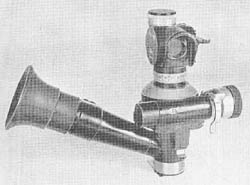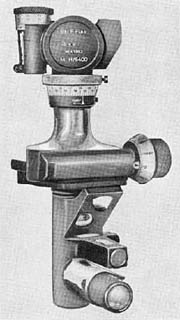 The Rundblickfernrohr 40 is believed to have been designed for use with the 7.5 cm L. G. 40 or the 10.5 cm L. G. 42. A carrying case and two night lighting devices employed with the instrument were also recovered.
The Rundblickfernrohr 40 is believed to have been designed for use with the 7.5 cm L. G. 40 or the 10.5 cm L. G. 42. A carrying case and two night lighting devices employed with the instrument were also recovered.
This is a panoramic artillery sight, consisting of an upright section approximately five inches long, supporting an objective head which has a full 360° traverse, and an eye piece approximately four inches long set at an angle to the base. The eye piece traverses approximately 200°, permitting the operator to use the sight from different positions. A knob graduated in mils and numbered on each ten mils is located near the center of the upright section and traverses the objective head. The lower section of the objective head is graduated in hundred mils, the even hundreds being numbered. By pressing a small lever near the adjusting knob, free traverse of the head for quick spotting is possible.
An adjustment for elevation is controlled by a knob on top of the objective head which is graduated in hundredths and numbered on each tenth mil graduation.
An unusual feature in this sight is that the adjusting knobs are click mounted to enable adjustments to be made at night without light.
Two night lighting devices are provided with the sight. One mounts on the left side of the eye piece and illuminates the reticle with a red light which is regulated by an aperture in the attachment. The other is worn by the operator for reading graduations on the sight and has an aperture selection for either clear or red light. It is held in place on the forehead of the operator by an elastic strap.
Weight of the sight is approximately 2 1/2 pounds.
German: p. 185 (August 1, 1945)
 The Rbl. Flak is used with heavy antiaircraft guns for indirect fire against ground targets and for reciprocal laying. A modified type is designed for use with the predictor.
The Rbl. Flak is used with heavy antiaircraft guns for indirect fire against ground targets and for reciprocal laying. A modified type is designed for use with the predictor. The Rundblickfernrohr 40 is believed to have been designed for use with the
The Rundblickfernrohr 40 is believed to have been designed for use with the